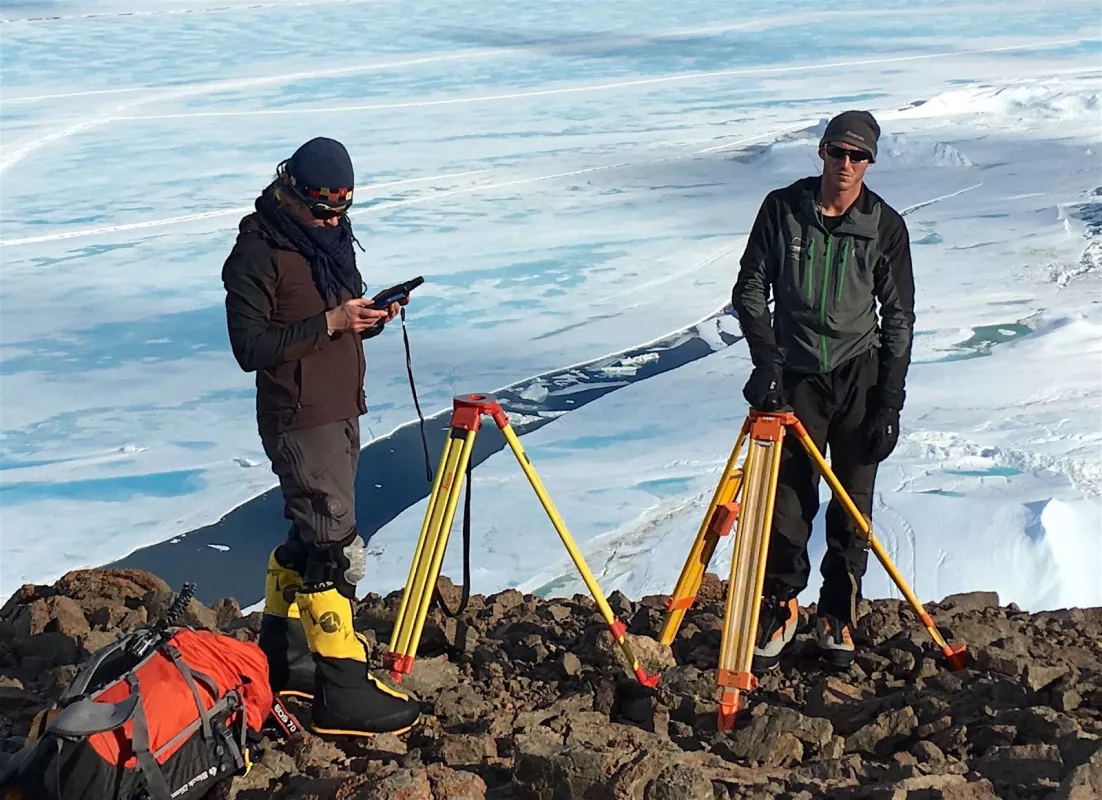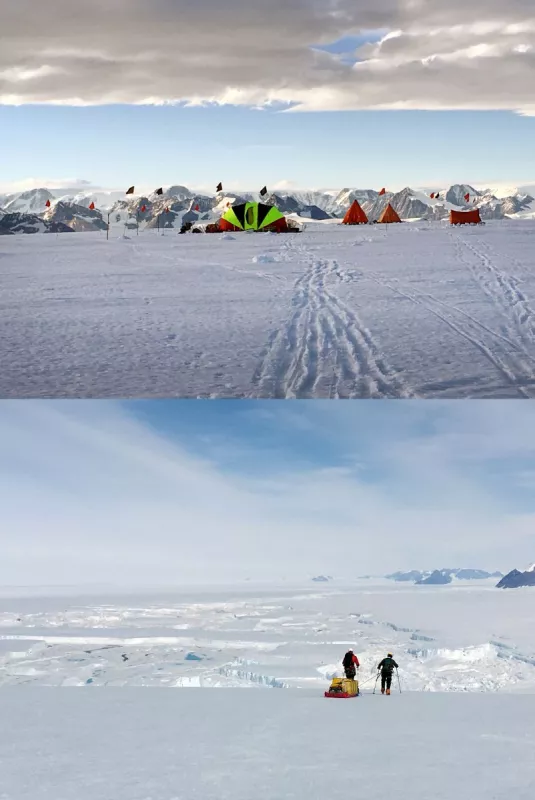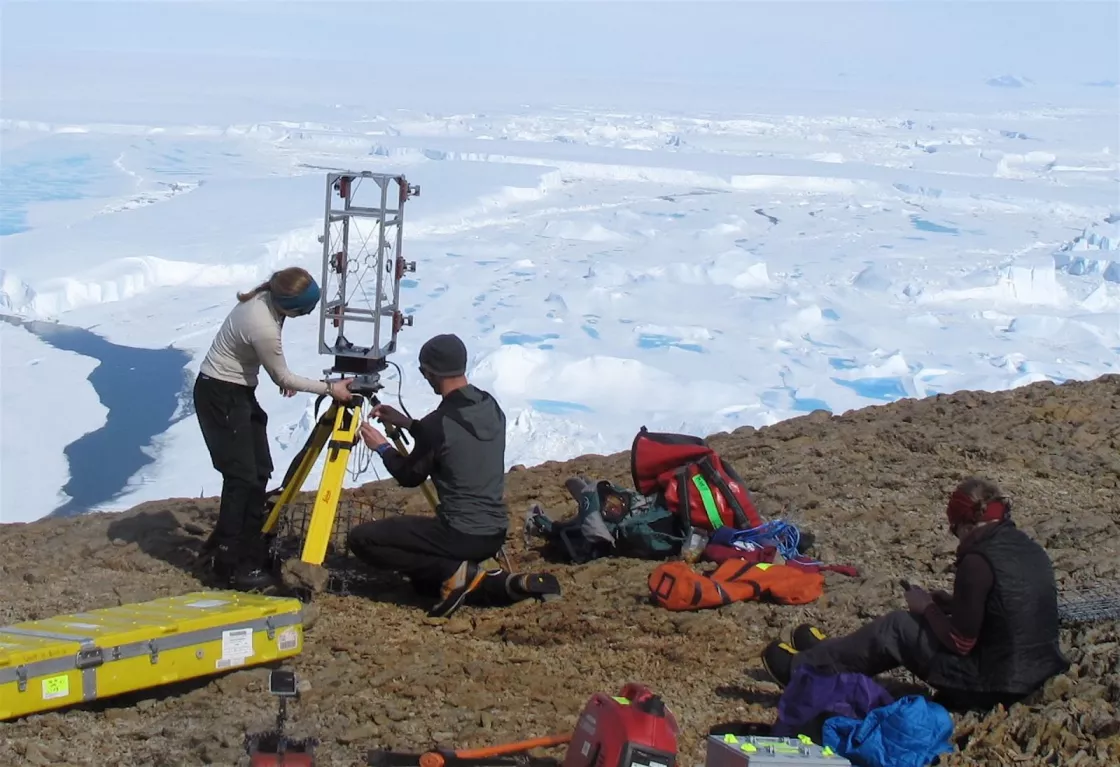By Agnieszka Gautier
In 2002, a major chunk of the Larsen B Ice Shelf on the Antarctic Peninsula collapsed, an area comparable in size to Rhode Island. In the dramatic collapse, hundreds of square miles of ice, over 600 feet thick, shattered into thousands of blocks in just a few weeks.
Now the remaining ice shelf, known as Scar Inlet, has weakened and verges on collapse. NSIDC scientist Ted Scambos flew with a team of scientists to Antarctica in February 2016 hoping to witness this spectacle. Though Scar Inlet survived this year, the team saw something unexpected, and more intriguing, if a bit less dramatic.
A glimpse into the future
Ice shelves are the final stage of an ice sheet’s mighty march out to the ocean, a floating thick ice plate that is sensitive to changes from both the air and the ocean. From north to south, the Larsen Ice Shelf is separated into three segments. Larsen A, the smallest and most northern portion, crumbled in 1995. For now, the largest and most southern portion, Larsen C, appears stable. In the middle, Larsen B is mostly collapsed, but still evolving rapidly. “For several years, we’ve been instrumenting this part of Antarctica so we could measure ongoing changes and capture in detail what happens at the moment of break up,” Scambos said.
Prior to 2002, the Larsen B Ice Shelf had clung to the Antarctic Peninsula since the last major glaciation 12,000 years ago. Now the peninsula, a mountainous, wispy tail on Antarctica, is a hotspot for global warming. Since 1940, it has been warming 0.5 degrees Celsius (0.9 degrees Fahrenheit) per decade, one of the fastest regional rates observed. In recent years, however, summers have been cool, and a layer of frozen seawater, called fast ice, has filled the gap of the collapsed portion of Larsen B.
The end of February marks the peak of Antarctica’s summer. Scambos and the research team had a strong suspicion that the Pacific’s El Niño conditions would bring a warm summer to the Peninsula. Cape Disappointment, the selected vantage point, offered an excellent view of Scar Inlet. But instead of a collapse, the researchers were given an opportunity to study another process up close—how the new fast ice is affecting the shelf.
Not all disappointment
Initially, after the 2002 Larsen B collapse, Scar Inlet cracked and flowed rapidly into newly opened waters. But since 2011, fast ice has survived every summer, getting older and thicker. Fast ice is a solid sheet of sea ice bound to the coastline. Unlike sea ice, fast ice does not drift. It “holds fast” to the coastline, providing an eggshell-thin veneer of ice where once a thick plate resided. “In the last few years, there’s been a lot of frozen ocean ice, a big smooth sheet of it,” Scambos said. “It’s only a few meters thick, but appears to be slowing down the break-up event.”
Fast ice moves like an accordion, expanding and compressing as glaciers and Scar Inlet push against it. “It’s a bit cracked, so it’s weak. It shrugs and shifts during storms. But it’s not breaking out. Not yet,” Scambos said. The team brought instruments sensitive enough to measure the interaction between the ice shelf and fast ice. Where was fast ice buckling? How did it inhibit further calving of the ice shelf?
A cape with a view
The most effective instrument, a radar, sat on the coastline and looked out on the icy landscape, sweeping its large antenna every few minutes. Pairs of images could be processed to detect tiny changes. “It shows us how the ice had moved on the millimeter level in that interval,” Scambos said. Now motion within the ice could be spotted. Those intervals of time could be stretched to observe more drastic changes. “This instrument was a life-saver because of the detail it provided,” he said. The radar added information on the dance between ice shelves and fast ice, and gave insight into how new ice shelves might form.
“We were right in our guess that the El Niño year would lead to increased melting,” Scambos said. “When we got there the fast ice was flooded with water, and it looked like we were camped at a Caribbean beach with turquoise sea waters stretching to the horizon.” These pools of melted water collect on the fast ice surface, forming melt ponds. In 2016, the fast ice experienced the most melting in its five summers of residence.
With their new measurements, Scambos and his team can analyze just how this relationship plays out. The leading idea is that fast ice acts like a brace on the ice shelf, reducing iceberg calving. Scambos thinks it will take a significantly warm summer to kick out the fast ice. Then, with nothing at its front, the remnant ice shelf would rapidly break up, launching a new round of fast-paced evolution for the Larsen B glaciers.
“So Cape Disappointment was not all disappointment,” Scambos said. Timing is everything, and even though the disintegration did not happen this year, the researcher’s preparation gave them a glimpse into ice shelf processes, confirming that fast ice might be impeding the collapse, for now.



